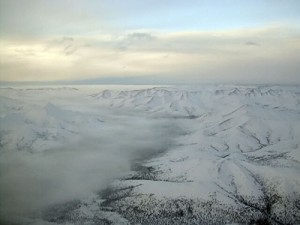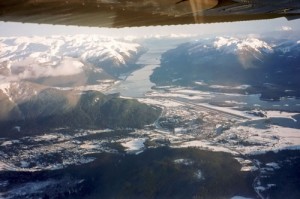
With a dearth of level land around Juneau, Alaska, pilots must normally practice training maneuvers over water.
By Greg Brown
“Guess what!” said my friend Chris Sis. “I’ve just been hired as an Alaska Airlines pilot!”
As long as I’ve known Chris, flying for Alaska has been his dream job. Being hired by any major airline is no easy feat, and it couldn’t have happened to a more deserving guy.
I thought back to first meeting Chris through an online pilot forum I hosted. He was noteworthy from the beginning for his aviation expertise, often answering others’ questions about the latest aircraft technology. I quickly concluded that the man must be a commercial pilot. But then one day we had a forum guest representing Embry-Riddle Aeronautical University, and to my surprise, Chris asked about admission requirements. I keyed him an “instant message.”
“Are you returning to school for an additional degree?” I asked.
“Oh no,” came the reply. “I’m only 15. I haven’t had my first flying lesson yet.” Impressed, I invited him to assist in hosting the forum.

Chris Sis’ fingers were so cold when he parked his Cessna 150 at Haines on his first solo cross-country that he had difficulty retrieving change to make his promised phone call to his mother.
Soon afterward, Chris started flying lessons at Fallbrook Community Airpark (L18) near San Diego, Calif., and then continued at Juneau, Alaska, after moving there with his parents. Juneau is one tough place to learn to fly; with 278 overcast days per year, good flying weather is infrequent, and the dearth of level land means that flight maneuvers are practiced over frigid Alaskan waters. Chris wrote me after every lesson—I’ll never forget his account of circling a humpbacked whale on his first solo cross-country.
The young man paid for his lessons by digging ditches and working at a grocery store. Unfortunately for his parents, Chris’s flying obsession displaced the normal teen goal of driving; his folks eventually tired of transporting him between home, work and the airport. To their relief, he finally earned his driver’s license after becoming a private pilot.
When not flying, Chris admired the jets at Juneau’s airline terminal. One day, Alaska Airlines’ Capt. Mike Baumgartner invited Chris into his Boeing 737 cockpit. Mike reminisced about his own introduction to flying—as a 9-year-old returning with his parents from Europe, a pilot invited him to the cockpit of a Pan American Boeing 707 jetliner.

Chris Sis (right) poses with Austin Brown alongside a Grumman amphibian at EAA AirVenture Oshkosh, shortly after earning his instrument rating at age 17.
“We were over the Greenland ice cap at the time,” said Mike. “I was so taken by the experience that I vowed to become a pilot.”
The 707 captain entered the flight information in Mike’s journal and signed it. Mike quickly became Chris’ friend and mentor. By then I’d learned that Chris’ talents included writing as well as flying. My favorite of Chris’ published stories tells of how Mike discovered his childhood notebook, and from the still-legible signature, tracked down the long-retired Pan Am captain who had introduced him to flight. What a reunion that must have been.
Not until Chris graduated from high school did I finally meet him in person—he roomed with my son, Austin, while earning an instrument rating in Tucson, Ariz. For such a capable young man, Chris proved captivatingly low-key and modest. Afterwards, Chris hung out with Austin and me at EAA AirVenture Oshkosh.
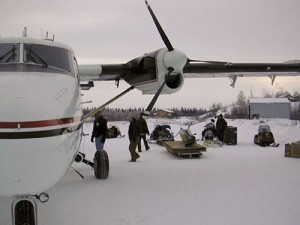
An Era Aviation DHC-6 De Havilland Twin Otter delivers supplies to an Eskimo community near Bethel, Alaska.
Chris earned his commercial pilot certificate during his first semester at the University of Alaska Anchorage, and took an after-school ramp job with the local regional airline, Era Aviation. When Era announced it was hiring pilots, Chris applied. To his surprise, he received a job offer. Later he learned that the company had interviewed him thinking it would be a good learning experience for someone just out of high school, but Chris did so well that they hired him. Pilot positions were to be filled in order of ground school academic performance. Juggling fulltime airline classes with his university coursework, Chris beat out more experienced pilots to ace the ground school. Within weeks, he was flying right seat in a de Havilland DHC-6 Twin Otter.
That summer my young friend emailed tales of flying scheduled service from Era’s Bethel base to surrounding Eskimo communities, their gravel runways lighted at night by smudge pots. Attached were photos of loading the airplane’s cargo hold from snowmobiles and stunning views of Alaska from the air. Most impressive were shots of his Twin Otter after landing on a narrow sandy beach—under airline flight rules, no less.
In winters, Chris flew from Anchorage. Even while piloting fulltime for Era, he continued fulltime studies as an on-campus University of Alaska student.
“How is all that possible?” I once asked.
“Oh, it’s not that bad,” replied Chris. “I just bid nighttime flying schedules so I can attend class during the day. It’s pretty tiring, though.”
Apparently, Chris found time to do his homework. I later learned from his résumé that he graduated magna cum laude.
After college, Chris scored a first officer position flying regional jets for SkyWest Airlines out of Salt Lake City. At the young age of 21, he qualified to skip the simulator proficiency portion of the interview, having already logged more than 1,000 hours of turbine airline experience. Once old enough to earn an airline transport pilot certificate (23), Chris upgraded to captain on the twin-turboprop Embraer Brasilia, and then qualified as a check airman.
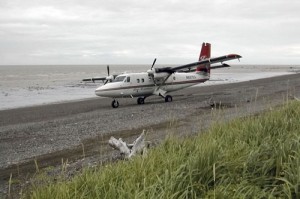
An Era Aviation Twin Otter flies airline service to a beach on Alaska’s Cook Inlet. Such missions were timed to coincide with low tide.
By then, Chris was a very busy guy. Gone were the days when he wrote regularly to share flying adventures, though on occasion he still emailed spectacular photos taken from his cockpit. How different his piloting experiences were from my own, and yet how similar—the camaraderie of adventure binds every pilot.
I’ll admit to a lump in my throat when Chris shared the good news about his employment by Alaska Airlines. It seemed like just a few months before that I’d counseled a wide-eyed 15-year-old about becoming an airline pilot. Now here I was congratulating him on fulfilling his lifelong ambition. Did I mention that Chris is only 24? Dreams really do come true.
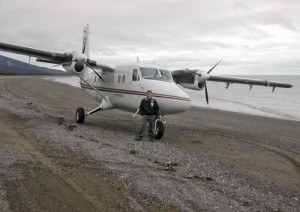
Chris Sis poses with an Era Aviation Twin Otter at Cook Inlet. The photo isn’t crooked—imagine landing at such an angle!
Author of numerous books and articles, Greg Brown is a columnist for AOPA Flight Training magazine. Read more of his tales in “Flying Carpet: The Soul of an Airplane,” available through your favorite bookstore, pilot shop or online catalog, and visit [http://www.gregbrownflyingcarpet.com].












